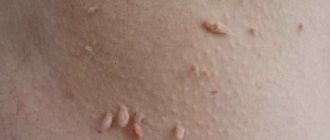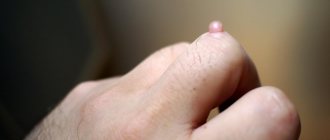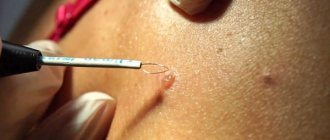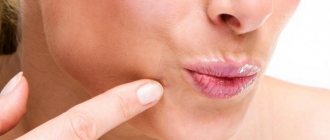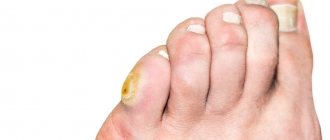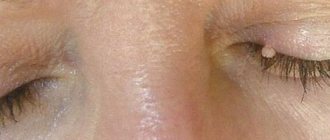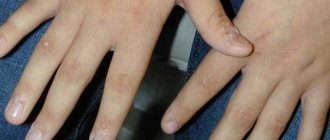Characteristic features of warts and calluses
It is not difficult for an experienced dermatologist to distinguish a wart from a callus through a visual examination procedure. A person encountering this problem for the first time should know the features of neoplasms. The symptoms of the diseases are similar: the patient experiences unpleasant pain when pressing on the diseased area. The main location of plantar warts is on the soles of the feet, and less commonly, on the palms. The reason for their appearance is the penetration of the human papillomavirus into the body against the background of decreased immunity. The disease is infectious in nature and is transmitted through contact through personal hygiene items, in swimming pool locker rooms, when using public soap facilities, and walking barefoot. The virus enters the body through microcracks in the skin, the incubation period takes from 2 weeks to 2 months, during which time the first signs of the disease appear. When a wart is injured, there is a high probability of its proliferation, which means the appearance of new papillomas in a limited area with the possibility of their combining into one large lesion.
A callus is a growth of keratinized skin with a thickening in the center that goes deep into the tissue; it resembles a depression with a plug inside. This callus is localized on the palms, soles, phalanges of the fingers and between them. At the initial stage, the seal itches and causes discomfort when pressed. Doctors say the causes of dry calluses are wearing tight and uncomfortable shoes, and excessive exposure to the skin due to physical activity. The causes may be viruses and mechanical damage to the skin: a plant thorn, an insect sting, microscopic shavings.
What is a wart
A wart is a small growth that is hard to the touch and can appear on the skin and mucous membranes. In most cases, this is a benign neoplasm, the appearance of which is provoked by the human papillomavirus. There are about a hundred of its varieties. Scientists have studied them well and identified three groups of strains to determine the risks of infection. The first includes those that have low risks of oncogenicity, the second – medium, and the third – high. The virus does not activate immediately when it enters the human body. First, it experiences an incubation period, and then falls into a latent form and waits in the wings. Warts appear when immunity decreases.
Types of calluses and warts
A wet callus occurs on the heels or little toes from friction when wearing new shoes; it will go away without consequences after a few days of treatment. The same applies to dry calluses when removing the load on the damaged area of the skin. Another type of growth, dry callus, can penetrate deeper into the skin without adequate treatment. Its shaft will thicken, causing more discomfort to the patient. Microcracks may appear on the skin, which can become infected. There is no need to delay diagnosis and treatment.
Medicine classifies warts as follows:
- flat;
- periungual;
- plantar;
- seborrheic;
- genital warts;
- vulgar;
- hanging: finger-shaped and villous.
All types of warts are of viral origin and are benign. If papillomas are ignored, they can develop into malignant ones; if symptoms appear, you should make an appointment with a doctor.
We recommend reading
- How to treat a callus on a child's heel
- How to remove calluses on toes: softening and removal
- Compaction on the sole of the foot - causes, treatment, prevention
Why do plantar warts occur?
The photo shows a plantar wart
Plantar warts have the same origin as papillomas, condylomas - papillomavirus. This pathogen spreads among people through contact and household contact. Infection occurs by shaking hands, kissing, using common household items, and walking barefoot in public places.
The virus penetrates the skin of the feet best in a moist and warm environment. Therefore, the easiest way to catch the disease is when visiting a swimming pool, sauna, or gym without replacement shoes.
If the immune system is strong enough, then infection may not occur or the virus will remain in the body in a latent state. But any malfunction in the functioning of a person’s defenses will lead to the formation of plantar warts.
In addition, the likelihood of the formation of plantar warts increases with excessive sweating of the feet, wearing uncomfortable tight shoes, various types of foot deformities (arthritis, osteoarthritis, flat feet), diabetes, varicose veins, and atherosclerosis.
In appearance, such a neoplasm resembles a hard nodule with clear edges that protrudes above the surface of the skin. The size varies between 1-2 cm. The color of the wart may be flesh-colored or become darker over time as the upper layers of the skin become keratinized.
Initially, the plantar wart is smooth, but gradually its surface is covered with a stratum corneum of cells and becomes rough. Often a small funnel, as well as dark dots, appear in the center of the neoplasm. The latter are traces of clogged capillaries.
Most often, a plantar wart is formed in a single copy. If there are a lot of such growths, this means that the virus has become overly active, and the patient’s immune system cannot cope with it.
How to distinguish growths from each other
The first thing a modern person does when he feels the manifestations of a disease is to go on the Internet to look at photos of similar symptoms. If it is impossible to see a specialist if lumps and growths appear on the skin of the feet or palms, you can determine the nature of the damage with similar symptoms at home. For diagnostic purposes, the affected skin is steamed in hot water with the addition of herbal decoctions, soda, salt or antibacterial soap. After steaming, carefully remove the dead skin layer. Visually, the viral lesion presents multiple pinpoint hemorrhages with black dots throughout the defect area, extending into the tissue. The surface of the callus will remain light and slightly lumpy with no signs of blood flow.
Another way to recognize whether there is a callus or a wart on the foot is by palpating the tissue around the growth. When pressing near the location of the problem, the pain will be absent in the presence of a corn (or intensify, which indicates that the patient has a plantar wart). This is due to the nature of tissue damage: the callus consists of dead cells that lack nerve endings and blood circulation. Plantar warts do not interfere with blood circulation in the affected tissues; cells and nerve endings, although affected by viruses, remain alive. The pain syndrome when pressed is significantly pronounced.
Another sign that helps to distinguish between two similar defects is the degree of its expression above the surface of the skin. The wart is always flat, the callus has a sharp apex.
Comparative characteristics of neoplasms
Calluses (corns) and warts are recognized by their characteristic structure and symptoms.
The corns are superficial, softer and more uniform, painful when pressed. It is close to the capillaries. The callus is dry, keratinized, does not require blood supply, finger pressure does not cause pain. Its shape resembles a flat mushroom on a stalk that goes deep into the skin. A wart-papilloma is a living tissue, fed by capillaries and reacting with pain to irritation.
Another difference is that a callus forms only at the point where force is applied. The spines grow into healthy areas of the skin. The contact of their scales with the virus on clean tissue causes the growth of the same warts.
Features of treatment
The disease is easier to prevent than to treat. Confirmation of the diagnosis in a hospital setting consists of a visual examination of the defect and a number of tests: PCR for the presence of HPV in the body, cytological examination, ultrasound to determine the depth of the roots of the formation. Depending on the information received, treatment methods may be different or similar.
| Plantar wart | Callus |
|
|
Plantar warts can be damaged and removed only in medical institutions. Otherwise, it will spread to a larger area and create conditions for infecting other people through contact.
Removal of the callus can be carried out in beauty salons; pedicurists successfully cope with this problem by drilling out the callus. Pharmacies offer patches and ointments based on salicylic acid, which can destroy damaged cells and the callus core itself. After wearing such a patch for 2-3 days, the core of the growth can be removed with ordinary tweezers, leaving a small depression in its place. Removing core corns at home from a child is not allowed!
Medical treatment of the described problems requires the patient to visit a doctor once; relapse after using the means of modern science is unlikely, but for the purpose of prevention, a number of procedures are necessary. Since papillomas and warts are caused by viruses, after excision, the doctor prescribes antiviral drugs to the patient. Recommends changing your shoes, and if you have frequent calluses, visit a podiatrist.
Folk remedies for the treatment of warts
Traditional medicine has remedies that can completely replace traditional treatment regimens. Warts can be removed using celandine juice, garlic and potatoes. Berry fruit drinks, mixtures of dried apricots, prunes, walnuts, raisins (all ground in a meat grinder and seasoned with honey), and fish oil will help strengthen the immune system. But such recipes can only be used if there is one hundred percent certainty that the infection with the human papillomavirus was caused by a non-oncogenic strain. Therefore, if any wart appears on the body, you must first meet with a dermatologist. After examining him, conduct a series of diagnostic examinations, discuss their results with a specialist, and then decide on the choice of treatment.
Preventive measures
Among the general preventive measures in the treatment of plantar warts and calluses, doctors note:
- maintaining a healthy lifestyle, giving up bad habits;
- strengthening the immune system: hardening, rubbing;
- taking vitamin complexes;
- body hygiene;
- personal hygiene items;
- wearing comfortable shoes and insoles.
Following simple rules will significantly reduce the likelihood of relapses, improve the patient’s quality of life, and prolong his youth and activity for several years.
The article has been verified by the editors
Disease prevention
The priority area of prevention is careful adherence to personal hygiene rules. It is necessary to bring your own replacement shoes in public swimming pools, baths and saunas. You cannot use other people’s bath accessories (washcloths, towels).
You should be careful when purchasing shoes. Preference should be given to those made from natural materials that allow the skin to breathe. If you have excessive sweating, you must use special cosmetics designed for foot care.
Doctors recommend avoiding close contact with people who have warts growing on their skin, and never touching their things. If your sexual partner has warts on the body or genitals, it is imperative to use barrier contraception during sex. Strengthening the immune system plays an important role in the prevention of warts. To implement this principle, you need to eat right, lead an active lifestyle, harden yourself, and treat any diseases in a timely manner.
